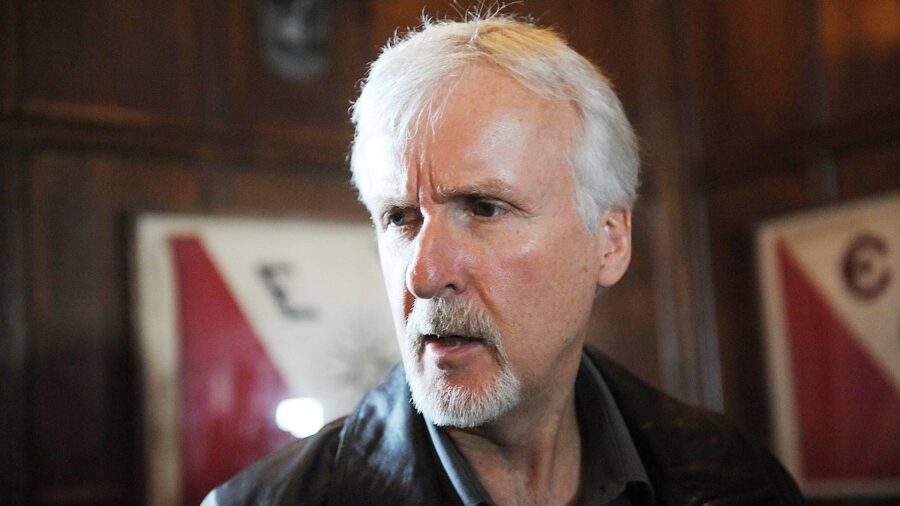James Cameron Leaves Epic Camera Goof In Iconic Movie Scene

Camera goofs are expected to happen when films are made, but James Cameron is one man who’s brave enough to just let them make it into the final cut. The most glaring example of a camera goof in his extensive and impressive filmography can be found in 1989’s The Abyss, when you can see a camera man wiping off the lens during one of the most intense scenes in the movie. When Virgil “Bud” Brigman (Ed Harris) and Dr. Lindsey Brigman (Mary Elizabeth Mastrantonio) are arguing over the oxygen mask during a scene that’s so claustrophobic that you’ll find yourself struggling to breathe, the shot is saved by none other than The Quilted Quicker Picker-Upper to make sure the entire sequence isn’t obstructed by water on the camera lens.
The Most Epic Camera Goof

James Cameron, who has once famously said “I look at every damn pixel,” was well aware of this camera goof in The Abyss, but he made the decision to keep the shot in the final cut of the movie because he had reason to believe that nobody would notice it. For the most part, he was right to make this decision because nobody even noticed the paper towel wipe until very recently. The scene was so gripping and well acted by Harris and Mastrantonio that James Cameron made the executive decision to keep the shot because it’s such a chaotic moment in the film that the last thing you’d think was obstructing the lens was the cameraman’s hand.
James Cameron Wasn’t Wrong To Leave It In

Most fans don’t even care about James Cameron’s camera goof in The Abyss because it never once occurred to them that it was a goof in the first place. When the slow motion version of the scene first started making its rounds online, people were quick to say that they originally thought it was just miscellaneous debris, or something dangling from the roof. But once the sequence is slowed down, it’s unmistakably a member of the production crew interfering with the shot, and it’s impossible to unsee.
A Problematic Production

Given how rough the production for The Abyss truly was, it’s reasonable to assume that James Cameron left the camera goof in the movie because he would have received a considerable amount of push-back if he made his cast and crew do reshoots. Production for the film took over six months, and the principal cast and crew were working six-day, 70-hour work weeks with less-than-desirable filming conditions. Ed Harris even had to hold his breath for long periods of time while being dragged around wearing a helmet full of liquid to get certain shots for the film, causing the liquid to rush into his eyes and nose on numerous uncomfortable occasions.
Given that edits typically take place after days of shooting, James Cameron’s camera goof wouldn’t have been discovered by his editors until after the filming for the scene wrapped, and he would be presented with a crucial decision to make: shoot the scene again, or just roll with it.
Everybody’s Goofin’

James Cameron isn’t the only filmmaker who leaves camera goofs in his movies because it’s sometimes impossible to work around them. My favorite camera goof of all time can be found during a very tense sequence in 1990’s Goodfellas. When Ray Liotta’s Henry Hill is whacked out of his gourd and driving around under the assumption that he’s being followed by police helicopters, the scene is shot from two different angles.
In this particular scene, Ray Liotta can be seen lighting a cigarette that he ends up holding with his left hand near the driver’s side window. During the same scene, seconds later, the camera is pointing at him from the front passenger seat, capturing his full profile. As the scene cuts back and forth between each angle, Ray Liotta has a cigarette in his left hand when the camera’s looking straight at him from the wind screen, but no cigarette in his hand from the other angle.
Great Acting Is More Important Than A Consistent Shot

Camera goofs are fun to point out, but they shouldn’t be worn as a badge of shame either. Great filmmakers like James Cameron and Martin Scorsese have to make decisions to move the production of a film forward, and they’re fully aware of how sometimes the best acted shots aren’t necessarily the most consistent when the footage gets edited down during the post-production process. If anything, camera goofs like this demonstrate how human error can find its way into some of the best movies we’ve ever seen without detracting from the storytelling.












